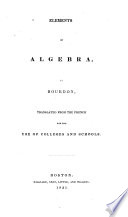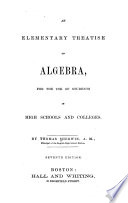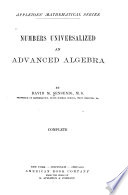 | Bourdon (M., Louis Pierre Marie) - Algebra - 1831 - 326 pages
...division the figures of the quotient are obtained by trial, while in algebraic division the quotient obtained by dividing the first term of the dividend by the first term of the divisor, is always one of the terms of the quotient sought. If these two terms are not... | |
 | Roswell Park - Best books - 1841 - 722 pages
...arranged according to the powers of some one letter ; after which the first term of the quotient is found by dividing the first term of the dividend by the first of the divisor. Of algebraic fractions, which are similar to arithmetical, we have no room to speak farther. § 2.... | |
 | Thomas Sherwin - Algebra - 1841 - 320 pages
...manifest that the first term of each successive divisor will be the same ; and, since we always divide the first term of the dividend by the first of the divisor, it is sufficient to find the first term of the first divisor and use that throughout; and, in subtracting,... | |
 | Roswell Park - Best books - 1847 - 626 pages
...arranged according to the powers of some one letter ; after which the first term of the quotient is found by dividing the first term of the dividend by the first of the divisor. Of algebraic fractions, which are similar to arithmetical, we have no room to speak farther. § 2.... | |
 | Thomas White (jun, of Portsmouth.) - 1848 - 112 pages
...terms, then arrange them both according to the powers of some one letter common to both, and divide the first term of the dividend by the first of the divisor ; the result will be the first term of the quotient, by which multiply all the terms in the divisor,... | |
 | 1876 - 400 pages
...contains a plus sign, the signs of the answer are alternately plus and minus. The first term of the answer is obtained by dividing the first term of the dividend by the first term of the divisor ; the last term of the answer may also be obtained by dividing the last term of... | |
 | George Albert Wentworth - Algebra - 1886 - 284 pages
...dividing the first term of the remainder by the first term of the divisor. In like manner, the third term of the quotient is obtained by dividing the first term of the new remainder by the first term of the divisor, and so on. Therefore, to divide one polynomial by another,... | |
 | George Albert Wentworth - Algebra - 1888 - 514 pages
...product of a, the first term of the divisor, by p, the second term of the quotient. Hence, the second term of the quotient is obtained by dividing the first term of the remainder by the first term of the divisor. And so on. Therefore, to divide one polynomial by another... | |
 | David Martin Sensenig - Algebra - 1890 - 556 pages
...difference of the quantities, and alternately positive and negative when it is the sum of the quantities. 3. The first term of the quotient is obtained by dividing the first term of the dividend by the first term of the divisor. 4. Each subsequent term of the quotient may be found by dividing the preceding... | |
 | George Albert Wentworth - Algebra - 1891 - 380 pages
...dividing the first term of the remainder by the first term of the divisor. In like manner, the third term of the quotient is obtained by dividing the first term of the new remainder by the first term of the divisor ; and so on. Hence we have the following rule : Arrange... | |
| |